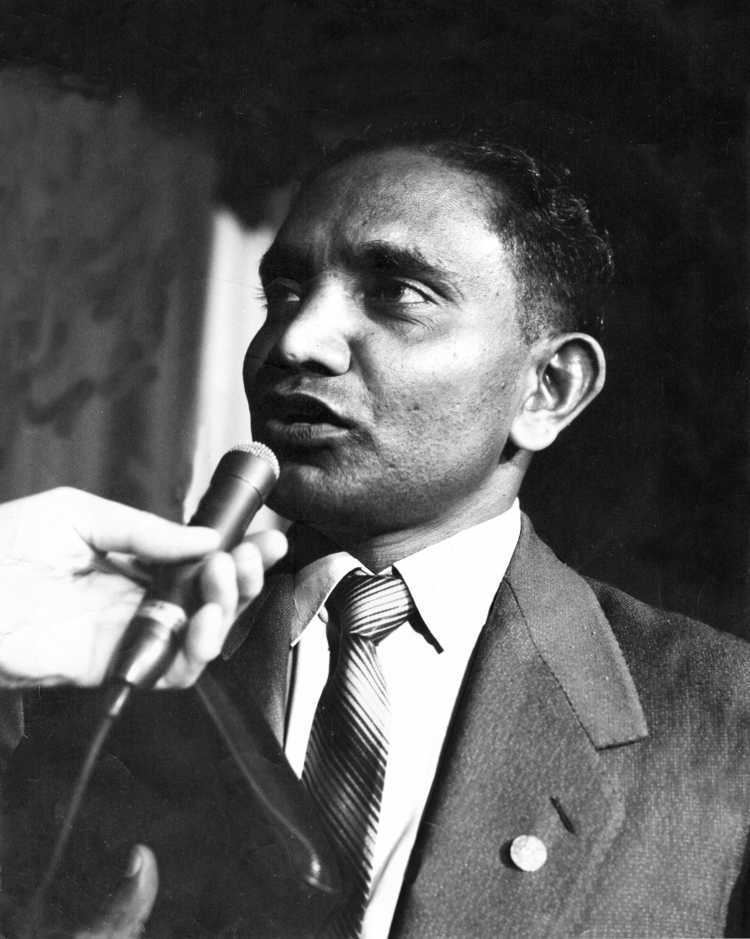Nationality Indian Occupation Religious leader | Name Paulaseer Lawrie | |
 | ||
Full Name Paulaseer Lawrie Other names Lahari Krishna, Iyyah (Eternal Father) Employer The Galaha Co (Ceylon), Harrisons Crossfield (Ceylon), Vellore Medical College Hospital (Vellore) Died February 24, 1989, Tirunelveli | ||
Paulaseer lawrie muthukrishna s universal prayer
Paulaseer Lawrie Muthukrishna (24 February 1921 – 24 February 1989); was an Indian preacher who had followers worldwide. He is known for his faith-healing movement and initiated the "One God, One Nation movement" in India.
Contents
- Paulaseer lawrie muthukrishna s universal prayer
- Kaaalamo Selludhe Valibhamum Maraiyudhe
- Early life education and early career
- Evangelical career
- References
Kaaalamo Selludhe, Valibhamum Maraiyudhe
Early life, education and early career
R. Paulaseer Lawrie was born to father, Deva Rasiah, and mother, Nesammal, at the Lakshmi Tea Estate in Munnar, Kerala.
Soon after his birth, the family moved to Ceylon (now Sri Lanka). Paulaseer stayed back to study at St. John's College, located in Palayamkottai, Tamil Nadu. After finishing the intermediate class of university studies, he went to Ceylon and studied commercial subjects for one year. He then went to Wesley College, Colombo, located in Colombo to gain the London Matric certificate.
After this, he went back to Madras, Tamil Nadu, and joined the Christian College, located in Tambaram, Tamil Nadu, for a Bachelor of Arts degree. As World War II began, a vigorous recruiting for officers was afoot. Paulaseer wanted to join the Indian Army and took some training. On knowing this, his father came over and forced Paulaseer to return with him to Ceylon. Paulaseer came back to India to continue his studies. He got a seat in St. Xavier's College, located in Palayamkottai, Tamil Nadu.
In August 1942, when the national leaders launched the Quit India Movement, he organized a big student strike in his college. The police attempted to apprehend him, but he managed to escape to Ceylon where, soon after arrival, he got a job in one of the tea estates as a stenographer. Around this time Paulaseer began to read political and religious works and to have visions. In 1946, he went to India on a short holiday. While going with his mother to a friend's house, he saw everything according to the dreams he had had about his wife-to-be. The church, the road, the house and its inmates and every detail flashed back in great vividness. Thus assured that the girl in that house was the one chosen by the Lord, he consented to marry, and they were engaged. His mother was there, but his father was in Ceylon. So the marriage had to be postponed for six months; it occurred 26 May 1947.
When his first child was seriously ill, Paulaseer prayed in an Anglican church and promised to devote his life to God if the child recovered. After his son's recovery, he resigned his job in Ceylon and returned to India. He took a job on the Yercaud Estate, located in Tamil Nadu, and later at the Christian Medical College Hospital, (CMCH)located in Vellore, Tamil Nadu.
Evangelical career
In response to more visions, Paulaseer resigned his job in 1953 in order to preach. He participated in a Bombay healing crusade of American evangelist William M. Branham in 1954, an acquaintance that was to be important later. A series of "miracles" sparked interest in Paulaseer's message. After preaching in various towns in South India, he crossed over to Ceylon on two missionary journeys. The first tour lasted from 25 October 1955 to 20 December 1955. The second longer tour was from 8 April 1956 until 17 June 1956.
After several years of evangelizing in India, Paulaseer was invited to an international conference in Scotland. From Scotland he went to the United States, where he attempted to acquire backing from an established Pentecostal ministry. This was largely unsuccessful until he met with Branham, who encouraged him in his ministry.
In 1967, Paulaseer took a long journey in the West, preaching to many of Branham's followers. In 1969 he took another tour, and this time some Branhamites experienced extraordinary things from his preaching. On 21 July 1969 – the day of the Apollo 11 moon landing – Paulaseer claimed to have become the second coming of Christ. His followers pointed to Branham's sermons to show that he recognized Paulaseer as such. Paulaseer adopted from Branham a prediction that the Rapture would occur in 1977, and that only 700 would be saved. Many American followers abandoned Paulaseer after his predictions for that year failed to come true.
In the 1980s, Paulaseer changed his message somewhat, teaching Aadhi Bali or "Supreme Sacrifice" – an idea from the Purusasukta. He began to draw much more on Hindu and even Muslim ideas, and attracted more native Indian followers.
